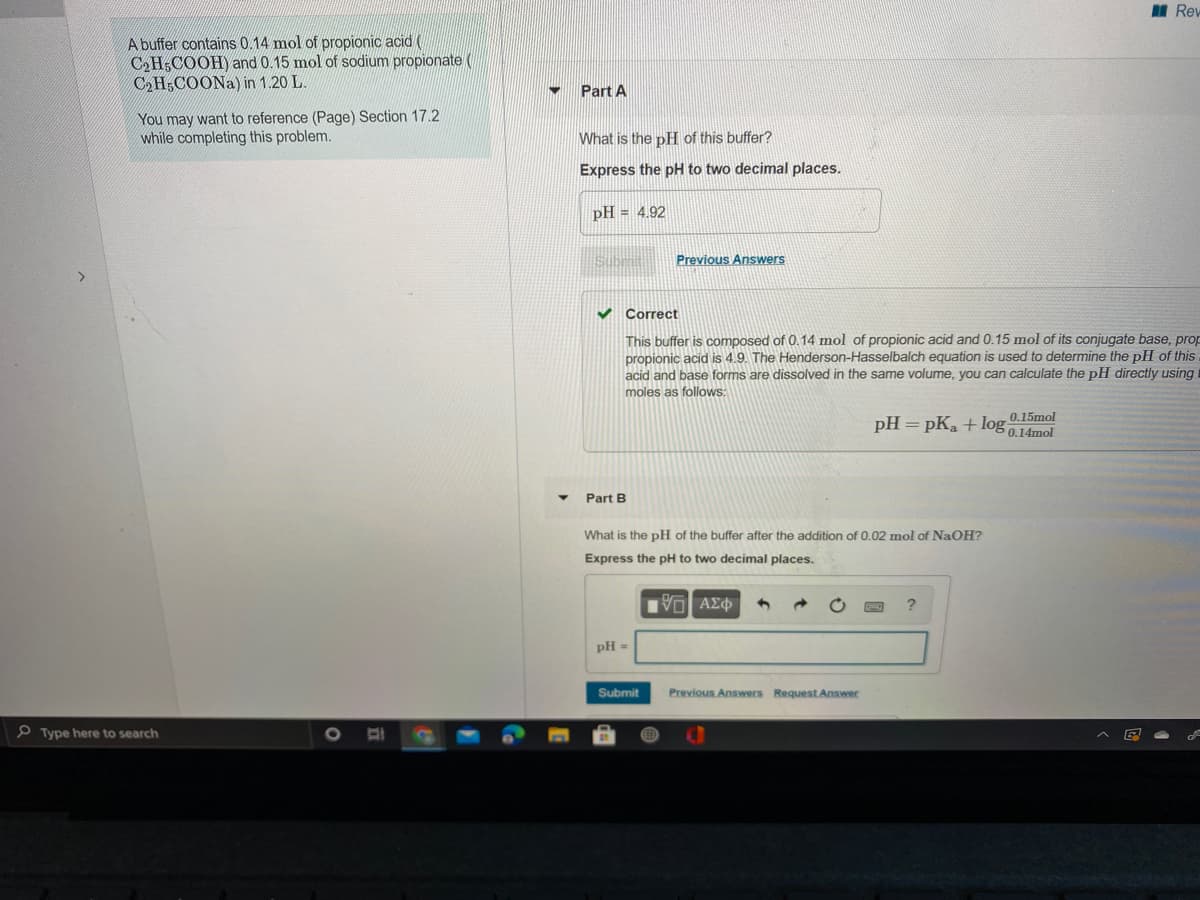A buffer contains 0.14 mol of propionic acid ( C2H;COOH) and 0.15 mol of sodium propionate ( C2H;COONA) in 1.20 L. Part A You may want to reference (Page) Section 17.2 while completing this problem. What is the pH of this buffer? Express the pH to two decimal places. pH = 4.92 Previous Answers v Correct This buffer is composed of 0.14 mol of propionic acid and 0.15 mol of its conjugate base, pr propionic acid is 4.9. The Henderson-Hasselbalch equation is used to determine the pH of th acid and base forms are dissolved in the same volume, you can calculate the pH directly using moles as follows: 0.15mol pH = pKa + log o.14mol Part B What is the pH of the buffer after the addition of 0.02 mol of NaOH? Express the pH to two decimal places. pH =
A buffer contains 0.14 mol of propionic acid ( C2H;COOH) and 0.15 mol of sodium propionate ( C2H;COONA) in 1.20 L. Part A You may want to reference (Page) Section 17.2 while completing this problem. What is the pH of this buffer? Express the pH to two decimal places. pH = 4.92 Previous Answers v Correct This buffer is composed of 0.14 mol of propionic acid and 0.15 mol of its conjugate base, pr propionic acid is 4.9. The Henderson-Hasselbalch equation is used to determine the pH of th acid and base forms are dissolved in the same volume, you can calculate the pH directly using moles as follows: 0.15mol pH = pKa + log o.14mol Part B What is the pH of the buffer after the addition of 0.02 mol of NaOH? Express the pH to two decimal places. pH =
Chemistry: Principles and Practice
3rd Edition
ISBN:9780534420123
Author:Daniel L. Reger, Scott R. Goode, David W. Ball, Edward Mercer
Publisher:Daniel L. Reger, Scott R. Goode, David W. Ball, Edward Mercer
Chapter16: Reactions Between Acids And Bases
Section: Chapter Questions
Problem 16.78QE
Related questions
Question
I need help with part b for number 6

Transcribed Image Text:Rev
A buffer contains 0.14 mol of propionic acid (
C2H,COOH) and 0.15 mol of sodium propionate (
C2H5COONA) in 1.20 L.
Part A
You may want to reference (Page) Section 17.2
while completing this problem.
What is the pH of this buffer?
Express the pH to two decimal places.
pH = 4.92
Previous Answers
Correct
This buffer is composed of 0.14 mol of propionic acid and 0.15 mol of its conjugate base, prop
propionic acid is 4.9. The Henderson-Hasselbalch equation is used to determine the pH of this
acid and base forms are dissolved in the same volume, you can calculate the pH directly using
moles as follows:
0.15mol
pH = pKa +log
0.14mol
Part B
What is the pH of the buffer after the addition of 0.02 mol of NaOH?
Express the pH to two decimal places.
pH =
Submit
Previous Answers Request Answer
P Type here to search
Co
Expert Solution
This question has been solved!
Explore an expertly crafted, step-by-step solution for a thorough understanding of key concepts.
This is a popular solution!
Trending now
This is a popular solution!
Step by step
Solved in 3 steps

Knowledge Booster
Learn more about
Need a deep-dive on the concept behind this application? Look no further. Learn more about this topic, chemistry and related others by exploring similar questions and additional content below.Recommended textbooks for you

Chemistry: Principles and Practice
Chemistry
ISBN:
9780534420123
Author:
Daniel L. Reger, Scott R. Goode, David W. Ball, Edward Mercer
Publisher:
Cengage Learning

Chemistry: Principles and Reactions
Chemistry
ISBN:
9781305079373
Author:
William L. Masterton, Cecile N. Hurley
Publisher:
Cengage Learning

Chemistry: An Atoms First Approach
Chemistry
ISBN:
9781305079243
Author:
Steven S. Zumdahl, Susan A. Zumdahl
Publisher:
Cengage Learning

Chemistry: Principles and Practice
Chemistry
ISBN:
9780534420123
Author:
Daniel L. Reger, Scott R. Goode, David W. Ball, Edward Mercer
Publisher:
Cengage Learning

Chemistry: Principles and Reactions
Chemistry
ISBN:
9781305079373
Author:
William L. Masterton, Cecile N. Hurley
Publisher:
Cengage Learning

Chemistry: An Atoms First Approach
Chemistry
ISBN:
9781305079243
Author:
Steven S. Zumdahl, Susan A. Zumdahl
Publisher:
Cengage Learning

Chemistry
Chemistry
ISBN:
9781305957404
Author:
Steven S. Zumdahl, Susan A. Zumdahl, Donald J. DeCoste
Publisher:
Cengage Learning


Principles of Modern Chemistry
Chemistry
ISBN:
9781305079113
Author:
David W. Oxtoby, H. Pat Gillis, Laurie J. Butler
Publisher:
Cengage Learning